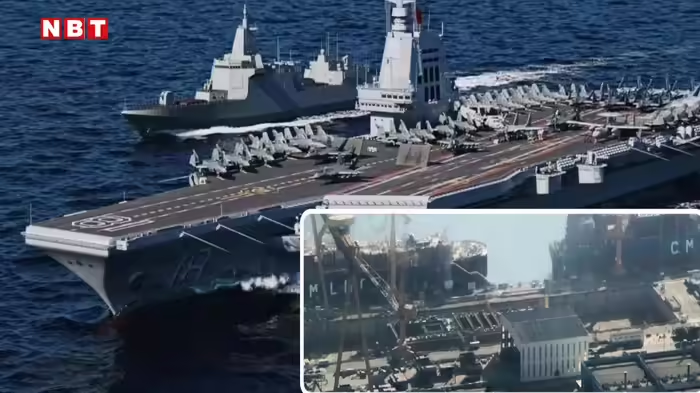
Beijing: In a major leap toward global naval dominance, China is reportedly building its first nuclear-powered aircraft carrier, the “Type 004.” Newly surfaced images from Dalian Shipyard in Liaoning Province suggest that the carrier’s hull structure includes a reactor containment unit, confirming suspicions that it will run on nuclear propulsion. Defense experts warn that this could significantly shift the power balance in the Indo-Pacific, posing strategic challenges for both India and the United States.
This revelation comes just a week after the People’s Liberation Army Navy (PLAN) launched its first domestically built aircraft carrier, Fujian. Reports also indicate that Beijing is simultaneously working on another conventionally powered carrier, further signaling its aggressive naval expansion.
A Major Step Toward Nuclear Naval Power
Analysts believe that the Type 004 will mark a historic transformation in China’s maritime capabilities. Nuclear propulsion will provide the ship with virtually unlimited range, enhanced operational endurance, and the ability to sustain advanced radar and weapon systems without frequent refueling — advantages that currently give the U.S. Navy’s supercarriers their unmatched dominance.
If confirmed, China would join only two other nations — the United States and France — in operating nuclear-powered aircraft carriers.
Images Reveal Key Details
Satellite and shipyard images show a massive reactor containment structure under construction, closely resembling those seen on U.S. Ford-class and France’s upcoming next-generation nuclear carriers. Experts suggest the design includes four catapult launch systems, including two on the waist, offering superior aircraft launch capacity compared to China’s Type 003 Fujian.
Some analysts, however, caution that the visible structure might belong to a test module or prototype section under development — part of China’s pattern of secretive experimentation before full-scale production.
Strategic Implications for the Indo-Pacific
The Pentagon’s 2025 military assessment acknowledged China’s ambitions for longer-range carrier operations, noting that new-generation Chinese carriers would enhance the PLAN’s power projection capabilities well beyond East Asia.
The Type 004 is expected to play a key role in China’s military ambitions in the Taiwan Strait and the South China Sea, regions already tense due to ongoing territorial disputes. A nuclear carrier would allow Beijing to maintain continuous naval presence without depending on frequent port refueling — effectively tightening its maritime grip in contested waters.
‘Dragon Might’ Nuclear Project
Evidence suggests that China has already built a land-based prototype nuclear reactor suitable for large surface vessels. The project, codenamed “Dragon Might,” is reportedly located near Leshan in Sichuan Province and is believed to serve as the testing ground for the reactor intended for the Type 004.
Race to Match American Naval Supremacy
Currently, China’s navy operates three conventionally powered carriers, far fewer than the U.S. Navy’s 11 active nuclear supercarriers. However, with the construction of the Type 004, experts believe Beijing is closing the gap faster than expected.
The ship’s development aligns with President Xi Jinping’s goal of turning China into a “world-class military power” by 2035. The move also complements the development of Type 076 assault carriers equipped with electromagnetic catapults designed for launching combat drones — systems that could be used in operations against Taiwan or to expand Chinese influence across the South China Sea.
A Growing Concern for India and the U.S.
The emergence of a Chinese nuclear supercarrier could significantly alter naval dynamics in the Indian Ocean and the Pacific. It would enable China to deploy carrier strike groups that rival the U.S. Navy’s global reach — and potentially outpace regional powers like India, whose carrier fleet remains conventionally powered.
Defense analysts warn that the Type 004 represents not just a technological milestone but a geopolitical signal — one that underscores Beijing’s determination to achieve military parity with Washington and challenge the strategic presence of India in the Indian Ocean region.
In summary, China’s nuclear-powered Type 004 carrier is more than just a ship — it’s a symbol of rising maritime ambition and an assertive challenge to U.S. and Indian naval influence. As construction progresses in Dalian, the world is watching closely to see how this floating fortress reshapes the future of global sea power.
Discover more from SD NEWS agency
Subscribe to get the latest posts sent to your email.